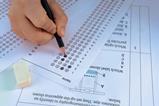Give atoms more attention from the start of secondary school to help students achieve their best results later at 14–16

‘Never trust an atom – they make up everything!’ Why, then, do we shy away from teaching about them in any real detail until students reach 14–16? When restructuring our 11–14 scheme of work, it struck me how little we really say about atoms at all, beyond simplistic definitions like: ‘Atoms are the smallest particle of an element’. And so students can feel that they encounter a huge barrage of new information with the ‘leap’ that follows as they progress in their learning.
By shifting some content down to ages 11–14, you allow the focus of 14–16 lessons to be on higher-order thinking skills. So you can deal with the ‘what’ at 11–14, and then cover the ‘how’ and ‘why’ at 14–16. I split the fundamentals up into three key sections: subatomic particles, electron arrangement and models of atoms, outlined below. I now cover each of these sections with my 11–14 classes, building knowledge and understanding ahead of 14–16.
From my experience, we all remember eating someone’s plum pudding
Focus on subatomic particles
Many existing schemes of work provide excellent foundations of what atoms are, stretching 11–14 students to consider what an atom is made up of: subatomic particles. In lessons on atomic structure topics for 14–16 learners, focus on the relative charges and masses of each particle, the size and scale of an atom, and the structure of isotopes. This gradual increase in complexity enables students to approach exam-style questions confidently, explaining concepts such as why an atom is neutral, and giving detailed comparisons between isotopes of the same element.
Complete electron arrangement
Learning about electron arrangement as 2, 8, 8 structure and drawing dot and cross diagrams can seem daunting at first, but is entirely accessible to younger classes, and is a task which students find extremely satisfying. When I feel I can stretch a class, we look at how reactive elements have incomplete outer shells, whereas inert noble gases have full outer shells. You can even discuss how metals and non-metals might achieve full outer shells, introducing basic principles of ion formation, revisited at 14–16.
By relieving the cognitive demand of dot and cross diagrams, you can focus lessons on how electron structures relate to reactivity, and on chemical bonding. It takes a lot of brain power to understand and apply these ideas, especially if a student’s working memory is also processing the electron arrangements for the first time.
Instead of a huge leap from 11–14 to 14–16 content, students feel confident in refining and applying chemistry they already know
Developing models of atoms
Many 14–16 exam questions focus on the evolution of scientific knowledge over time. It can feel like you’ve only just taught subatomic particles before further complicating students’ understanding of an atom by discussing how different models of atomic structure were developed and applying this to highly demanding questions. Instead, I set this up as a fun research project, where younger students have to make a model of the atom – edible plum pudding, anyone? Then, in a follow-up lesson, we admire (or eat) each other’s work and complete a simplistic comparison task. When recalling this at 14–16, it’s interesting to see how much students remember – from my experience, we all remember eating someone’s plum pudding. Since they can recall the ‘what’, lesson time is freed up to evaluate the ‘how’ and ‘why’ of the development of each model: the first tricky applications of how science works.
The benefits of this approach
Structuring our scheme of work in this way has undoubtedly improved my teaching. Gradually increasing the challenge maintains student enthusiasm and engagement with the subject. Instead of a huge leap from 11–14 to 14–16 content, students feel confident in refining and applying chemistry they already know, instead of feeling everything is new at exam level. The spiralised reinforcement and extending of content allows a shift in lesson focus: spending time practising explaining and evaluating, rather than stating and describing, develops a more skilful approach to exam questions, helping students achieve their best results.
More like this
Here’s how to teach atomic structure and periodicity to post-16 students.
Louise Hussein














No comments yet